Create a Monogram with a Border
-
Click File at the top left to open the Welcome screen.
-
In the Welcome screen, click Blank Canvas
 to start a new project. The Hoop selection dialog opens.
to start a new project. The Hoop selection dialog opens. -
In the Universal Hoop Group, set the Hoop Size to100mm x 100mm - Universal Square Hoop 1. Click OK.
-
In the Create tab, click ExpressMonogram
 . The Monogram page of the ExpressMonogram Wizard will appear.
. The Monogram page of the ExpressMonogram Wizard will appear. -
In the gallery at the top left, select the Small - Full - Small layout. This will produce a monogram with characters sized proportionally: small, full, small (SFS).
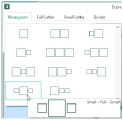
-
Enter the letters ’E’, ’S’ and ’J’ in boxes A, B and C.
E, S and J represent the name Elizabeth Jane Smith, using traditional monogram style where letters are used in the order of given name, family name, middle name. If the letters were all full size, EJS could be used as an alternative. -
In the Envelopes gallery, select the second envelope in the Classic 1 category. Its name is SFS_Classic02.
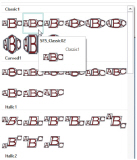
If you position the arrow pointer over a thumbnail without clicking, the name of the envelope will be shown.
The name stands for Small-Full-Small, using the second envelope in the Classic1 category.
In this envelope the small characters are relatively larger than those in the envelope to the left, proportions which are well suited to the curly initials to be used. -
Click Next
 , or click the Full Letter tab. The Full Letter page will appear.
, or click the Full Letter tab. The Full Letter page will appear. -
Click and drag the scroll bar on the side of the font list to see all the fonts in the Monogram category.
This category includes fonts that are recommended for the Classic envelopes using SFS (small, full, small characters). -
Click to select the font Curly UC 15-30mm.
-
Leave the font size at 23mm.
The initial size of a font is in the middle of the recommended font size range. -
Move the arrow pointer over the pink thread in the Thread Colors box and a popup description appears.
-
Click the pink thread color, and in the Thread Range drop-down list select Robison-Anton Rayon 40. The thread will change to Floral Pink, number 2415. Click OK.
-
Click Next
 , or click the Small Letter tab, and the Small Letter page will appear.
, or click the Small Letter tab, and the Small Letter page will appear. -
Ensure that ’Alternative style’ is selected.
-
In the Font gallery, select Curly UC 15-30mm in the Monogram category for the small letters.
Notice the Height measurement at the top of the window has changed. This is the height of the letter ’A’ for the small letter font. It should be within the recommended size range for the font (as mentioned in the font name). If the height is outside the recommended range, you may need to return to the Monogram page and change the envelope, or use the Full Letter page to change the full letter size.
measurement at the top of the window has changed. This is the height of the letter ’A’ for the small letter font. It should be within the recommended size range for the font (as mentioned in the font name). If the height is outside the recommended range, you may need to return to the Monogram page and change the envelope, or use the Full Letter page to change the full letter size. -
Click the pink color and the Color Selection dialog box appears.
-
In the Thread Range drop-down list select Robison-Anton Rayon 40.
-
Click pale pink in the Quick Colors (the second color square in the bottom row) and 2501 (Petal Pink) will be selected.
-
Click OK. The smaller letters are now a pale pink.
-
Click Next
 , or click the Border tab, and the Border page will appear.
, or click the Border tab, and the Border page will appear. -
Select Motif Line
 . The solid green border is replaced by a line of stars.
. The solid green border is replaced by a line of stars. -
Select Satin Line
 and the satin stitches appear again.
and the satin stitches appear again. -
Click the Thread Color icon
 to display the Color Selection dialog box.
to display the Color Selection dialog box. -
Ensure that ’Robison-Anton Rayon 40’ is selected.
-
Click pale pink in the Quick Colors (the second color square in the bottom row) and 2501 (Petal Pink) will be selected.
-
Click OK to close the Color Selection box. The satin border of the monogram is now pink.
-
Click Add Appliqué

. A gray fabric is placed behind the letters in the monogram. A matching fabric would enhance the embroidery.
-
Click Select Fabric

to open the Appliqué Selection dialog box.
-
Click the Color button above the Quick Colors palette. The Colors dialog box appears, with the Standard tab selected.

-
In the hexagonal matrix, click the medium pink hexagon sixth from the right (just to the right of the central white hexagon), then click OK. The new color is shown on the Color button and in the fabric preview.
-
Click OK to select the new fabric color.
Use Quick Fabric colors to preview your embroideries on a color similar to the fabric that you will use. Alternatively, select a patterned fabric. -
Click the ’Individual Letter Border’ checkbox to place lines between the letters in the monogram.
-
To see individual letter borders in the monogram, the spacing must be increased. Click the Full Letter tab to return to the Full Letter page.
-
Click the up arrow next to 1 in the Spacing section (the distance between the first and second letters) to increase it to 15mm.
-
Click the up arrow next to 2 in Spacing (the distance between the second and third letters) to increase it to 15mm. The letters now have individual borders.
-
For a traditional monogram effect, the letters may interlock. In the Full Letter page, set Spacing 1 to -3 mm, and set Spacing 2 to -4 mm.
-
Click Finish
 to close the wizard. The monogram is then displayed in the work area.
to close the wizard. The monogram is then displayed in the work area. -
In the Notes and Settings box, click Settings

.
-
Click Save As

to save the monogram in an adjustable form.
-
In the Save As dialog box, browse to \mySewnet\My Designs, and save it as EJS_Curly.
-

to export the monogram according to the desired Optimize for Sewing Options, for example to ColorSort the monogram to use the minimum number of thread changes.
-
In the Export dialog box, ensure that .vp4 is selected and click OK.
-
In the Save As dialog box, browse to \mySewnet\My Designs, and save the embroidery as EJS_Curly_exported.
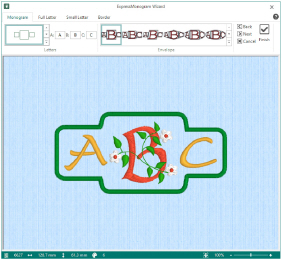
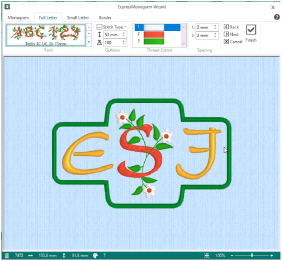
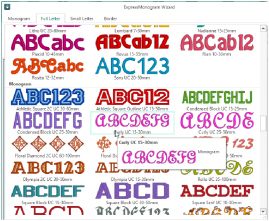
Notice the Height ![]() and Width
and Width ![]() measurements at the bottom of the window have changed. Use these as a guide to the size of your final monogram as you try different options.
measurements at the bottom of the window have changed. Use these as a guide to the size of your final monogram as you try different options.
If you have a desired final size you may need to alter the font size.
This only affects the letter S as it is the only ’Full’ letter.
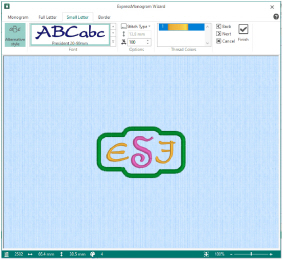
If Alternative style is not selected, the same font will be used for small letters as for the full letters.
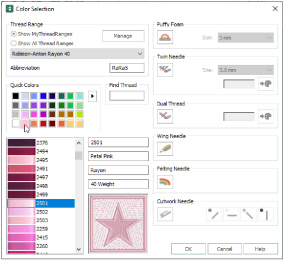
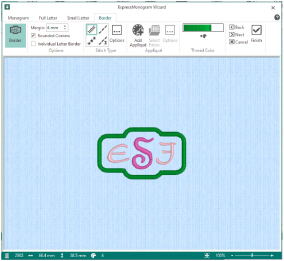
You can use a Motif Line
, a Satin Line
, or a Running Stitch
or Triple Stitch
line. The default border is a green satin line.

Although ’Individual Letter Border’ is now checked, The borders do not appear between the letters as they are relatively closely spaced.

This format may be desired when embroidering badges.
Notice that if you position the arrow pointer over a measurement box without clicking, the alternative measurement will be shown. You may also enter the alternative measurement with units of mm or " (including fractions) and it will be automatically converted.
The new positions of the letters can be seen in the Preview pane below. The border adjusts to fit.
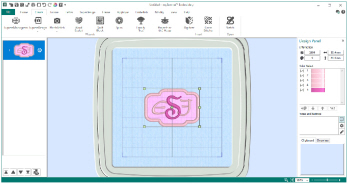
If you cannot see all the text, click Edit
.
The Settings give information on the letters, dimensions and font used in the monogram, including the font size for the large letter, and any patterns and fills used. This information can be used to recreate the monogram later, if it becomes fixed as embroidery.
Click the Edit button if you wish to edit these notes. The Settings dialog box is displayed. Amend the Settings as desired, then click OK to save your edits.
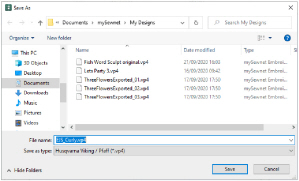
When you reopen this .vp4 file, right-click the monogram and select Properties in the Context menu to open the ExpressMonogram Wizard.
When a monogram is exported it is fixed as an embroidery, and can no longer be adjusted in the ExpressMonogram Wizard.
You could use the Background Wizard to preview the use of this monogram on a blouse or towel. See Backgrounds".